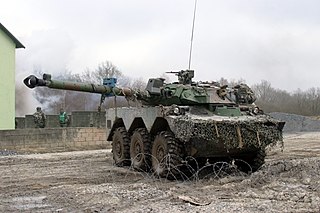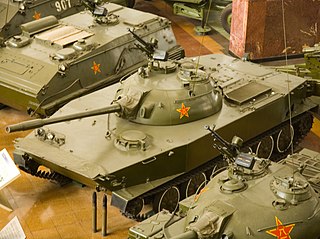
The T-62 is a Soviet main battle tank that was first introduced in 1961. As a further development of the T-55 series, the T-62 retained many similar design elements of its predecessor including low profile and thick turret armour. In contrast with previous tanks, which were armed with rifled tank guns, the T-62 was the first production tank armed with a smoothbore tank gun that could fire APFSDS rounds at higher velocities. While the T-62 became the standard tank in the Soviet arsenal, it did not fully replace the T-55 in export markets due to its higher manufacturing costs and maintenance requirements compared to its predecessor. Although the T-62 was replaced in Russia and the successor states of the Soviet Union, it is still used in some countries and its design features became standardised in subsequent Soviet and Russian mass-produced tanks.

The M48 Patton is an American first-generation main battle tank (MBT) introduced in February 1952, being designated as the 90mm Gun Tank: M48. It was designed as a replacement for the M26 Pershing, M4 Sherman variants and M46 Pattons used in the Korean War, and as the successor to the M47 Patton. Nearly 12,000 M48s were built, mainly by Chrysler and American Locomotive Company, from 1952 to 1961. The M48 underwent many design modifications and improvements during its production life. This led to a wide variety of suspension systems, cupola styles, power packs, fenders and other details among individual tanks.

The M60 is an American second-generation main battle tank (MBT). It was officially standardized as the Tank, Combat, Full Tracked: 105-mm Gun, M60 in March 1959. Although developed from the M48 Patton, the M60 tank series was never officially christened as a Patton tank. The US Army considered it a "product-improved descendant" of the Patton tank's design. The design similarities are evident comparing the original version of the M60 and the M48A2. It has been sometimes informally grouped as a member of the Patton tank family. The United States fully committed to the MBT doctrine in 1963, when the Marine Corps retired the last (M103) heavy tank battalion. The M60 tank series became America's primary main battle tank during the Cold War. Over 15,000 M60s were built by Chrysler. Hull production ended in 1983, but 5,400 older models were converted to the M60A3 variant ending in 1990.

The T-84 is a Ukrainian main battle tank (MBT), a development of the Soviet T-80 main battle tank introduced in 1976. The T-84 was first built in 1994 and entered service in the Ukrainian Armed Forces in 1999. The T-84 is based on the diesel-engined T-80 version, the T-80UD. Its high-performance opposed-piston engine makes it one of the fastest MBTs in the world, with a power-to-weight ratio of about 26 horsepower per tonne.

The Type 69 and Type 79 are Chinese second generation main battle tanks. Both were developments of the Type 59 medium tank with technologies derived from T-62. They were the first indigenously developed main battle tanks by China, although also classified as medium tanks while in development and service. Their lineage from the T-54A can be seen through the distinct gap between the first and second road wheels. Other improvements included a new engine, ballistic computers, and laser rangefinders. The more advanced Type 79 variant was equipped with a 105 mm rifled gun which was also found on the Type 80 tank.

The FV4201 Chieftain was the main battle tank of the United Kingdom during the 1960s-1990s.

A tank gun is the main armament of a tank. Modern tank guns are large-caliber high-velocity guns, capable of firing kinetic energy penetrators, high-explosive anti-tank, and cannon-launched guided projectiles. Anti-aircraft guns can also be mounted to tanks.

The AMX-10 RC is a reconnaissance vehicle built by GIAT. Over 240 are in service in the French Army. In addition, 108 vehicles were sold to Morocco and 12 to Qatar. RC stands for Roues-Canon, or wheeled gun.
Tank development both evolved considerably from World War II and played a key role during the Cold War (1945–1990). The period pitted the nations of the Eastern Bloc and the North Atlantic Treaty Organization (NATO against one-another.

Zulfiqar (ذوالفقار) is an Iranian main battle tank, conceived by Brigadier General Mir-Younes Masoumzadeh, deputy ground force commander for research and self-sufficiency of the armed forces. It is named after Zulfiqar, the legendary sword of Ali the fourth Caliph and the first Shiite Imam. It's also known as Zolfaqar.

The Infanterikanonvagn 91, Ikv 91, was a high mobility assault gun that was developed to meet the operational requirements of the Swedish Army. It was designed and manufactured by Hägglund and Söner and employed common components with the Pbv 302 armoured personnel carrier series. The first prototypes of the Ikv 91 were completed in 1969 with production running from 1975 until 1978. The total numbers manufactured were 212.
The Stingray, sometimes known as the Commando Stingray, is a light tank produced by Textron Marine & Land Systems division. It was specifically designed to use as many existing components of other American armored fighting vehicles as possible to keep costs down. The Stingray was a private venture project aimed at foreign countries. As of 2020, Textron has kept the Stingray name registered.

The Norinco Type 63 is a Chinese amphibious light tank. First fielded in 1963, it is in many ways similar to the earlier Soviet PT-76. However, contrary to the popular belief, it does have some essential differences from the PT-76 in the vehicle's waterjet propulsion system, etc. It is also known under its industrial designation, the WZ-211. Type 63 is being replaced by Type 63A.

The AMX-40 was a French main battle tank developed by GIAT during the latter stages of the Cold War as an export tank to replace the earlier AMX-32. Designed to be an inexpensive tank orientated towards militaries with smaller defence budgets, the AMX-40 featured a lightly armoured hull and good mobility reminiscent of previous French MBTs with a powerful 120 mm cannon. It however failed to attract interest and sales, rendering the project a failure, being discontinued in 1990.

The 2S25 Sprut-SD is a self-propelled tank destroyer or light tank developed and manufactured by the Volgograd Tractor Plant to meet the requirements of the VDV. In mid-2001, the Volgograd tractor plant revealed that the development of the 2S25 had lasted several years.

This article deals with the history and development of American tanks from the end of World War II, and during the Cold War.
Object 187 was a Soviet experimental main battle tank developed between the late 1980s and middle 1990s. It remains a relatively unpublicized development because of high levels of secrecy surrounding the project.

The CM-12 Tank is a modified M48A3 made for the Republic of China Army situated on Taiwan. The Armored Vehicle Development Center (AVDC) used the extra 100 fire-control system units from the production of the CM-11 Brave Tiger to modify the existing M48A3 tanks of the ROC Army. The modification was completed as of 1993. The CM-12 can be distinguished from the CM-11 by the rounded glacis plates, and from the M48A3 by the 105mm M68A1 cannon, which is longer than the 90mm T139/M3A1 cannon on the M48A3 and lacks a muzzle brake, and by the different commander's cupola.
The AMX 40 was a proposed French cruiser tank. It was intended to replace the SOMUA S35 and S40 tanks. The tank never went beyond design stage after the Fall of France.















